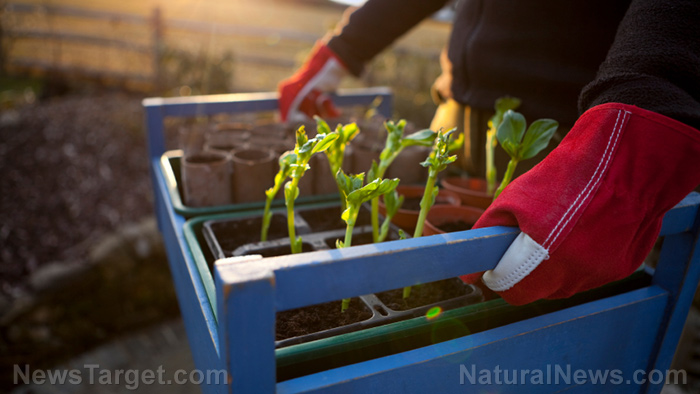Homesteading 101: How to protect your livestock from common predators
09/15/2020 / By Michael Alexander

Homesteading and farming can be very rewarding. However, it does come with several responsibilities, not the least of which is protecting your livestock from predation. (h/t to HomesteadAdvisor.com)
Classified as “wildlife damage,” predation ?– especially when left unchecked ?– can prove to be a costly problem for farmers and homesteaders in the long run. In fact, livestock losses attributed to predators cost U.S. ranchers and farmers more than $71 million annually, according to statistics compiled by the United States Department of Agriculture’s (USDA) National Agricultural Statistics Service (NASS).
According to experts, there are several animal species that can wreak havoc on farm animals and other livestock, some of which are even capable of dealing serious injuries to human beings:
- Hawks
- Owls
- Eagles
- Snakes
- Mink, skunks and weasels
- Opossums
- Raccoons
- Foxes
- Coyotes
- Feral cats and dogs
- Feral hogs
- Wolves
- Cougars or mountain lions
- Bobcats
- Bears
Complicating things, however, is that these animals, especially coyotes, bears and foxes, play a crucial role in dynamic ecosystems, according to experts, mainly due to their status as keystone species and apex predators.
As noted by wildlife experts, these animals help maintain an ecological balance by controlling the population of herbivores, thus maintaining the ecosystem by suppressing overgrazing, which could lead to habitat damage.
Because of their important role in the ecosystem, authorities have strongly recommended that lethal force be used only as a last resort, and that deterring them from entering one’s property should be the main priority. (Related: Limited space? Here are five dual purpose livestock for your farm.)
With that being said, here are some tips on how to prevent predation and avoid livestock loss on your homestead:
Make sure predators cannot get inside your property
When it comes to preventing predation, defense is the best offense. You can do this by putting up barriers, such as partly buried wire fencing, which can prevent most predators from jumping over and burrowing under.
You can put an electric strand at the top to prevent animals such as raccoons and opossums, which love to climb, from getting over.
If you are looking for something with a bit more of a kick, electrified net fencing and high-tensile electric wire fencing will suffice.
In the case of raptors and other predatory birds, however, overhead mesh fencing may be a better option.
Keep guard animals in order to intimidate would-be predators
Another way to prevent predation is to get animals to act as your livestock’s guardians, such as properly socialized guardian dogs, donkeys and llamas.
Guardian animals, according to experts, act as bodyguards for the livestock, thus allowing them to stay longer outside their pens to graze.
This option may be expensive, however, as properly socialized animals can fetch high prices on the market.
In addition, many factors have to be considered before getting an appropriate guardian animal, such as the terrain, the types of predators they will encounter, the number of animals to guard, total land area and proximity to neighbors.
Use “scare tactics” to deter predators
Installing devices that give off noise or flashing lights can be an effective deterrent against would-be predators.
These can include items such as automated noisemakers, lasers and devices, which mimic the eyes of large, alpha predators.
Shiny things, such as old CDs and Mylar strips, can also be hung on trees or near chicken coops to keep predatory birds out. Life-like toy snakes, when placed on roofs, are also known to deter birds.
It is important to note, however that when employing such methods, it is highly likely that the target predator will adapt to the tactics quickly. It is therefore important that these methods be integrated with other deterrents in order to be effective.
Don’t make your farm attractive to predators
Sometimes, it’s not your livestock that’s making your farm or homestead attractive to predatory animals ?– some of them might be attracted to your stocks of animal feed or your garbage, for example.
Here are some things you can do in order to prevent this:
- Avoid putting spoiled meat, eggs and dairy in your kitchen’s compost pile.
- Secure your stocks of animal feed and throw out any excess and uneaten food from feeding trays.
- Keep the animals’ living quarters clean and free from odor.
- In the event that an animal or two dies, promptly remove their carcasses and bury them in a location far from your farm.
Install traps to snare and catch predators
When worse comes to worst, and predatory animals keep on intruding into your property, it may be time to install humane traps.
Trapping animals is a serious endeavor that requires some research. This is because certain animals cannot be trapped in certain states, and even those that can be trapped are subject to certain policies implemented by authorities.
This means that you have to first find out rules governing trapping wildlife through your state department of fish and wildlife if you are planning to install traps on your property.
Protecting your farm and livestock from predators can be a challenging endeavor. However, with the proper guidance from wildlife and farming authorities, it can be done.
Sources include:
Tagged Under: animals, cattle, farm, farm animals, green living, Homestead, homesteading, livestock, off grid, Off-the-grid living, predators, sustainable living, wildlife
RECENT NEWS & ARTICLES
COPYRIGHT © 2017 GREEN LIVING NEWS

















